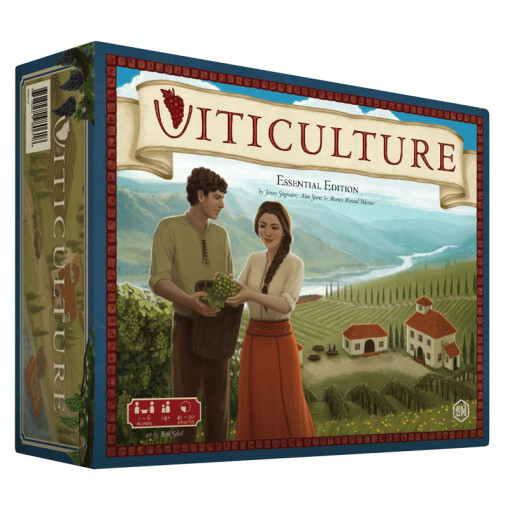We use cookies to make your experience better. To comply with the new e-Privacy directive, we need to ask for your consent to set the cookies. Learn more.
Viticulture Essential Edition Board Game
Definition: vi·ti·cul·ture – the cultivation of grapes; science or art of grape-growing.
As the sun rises in Tuscany Italy, the vineyards await the beginning of a new season with the challenge of growing and harvesting the finest grapes and producing the finest wines to fill the growing number of wine orders placed by shops and restaurants throughout the area. In this game of Viticulture, players send their workers to the vineyard – represented by the main game board, to perform different tasks: all with the goal of creating the most successful vineyard, and earning victory points towards winning the game. Viticulture plays during seasonal rounds, which repeat until one player obtains 20 victory points. Players earn victory points by filling customer orders for wine, using visitor cards and with worker placement on different spaces on the game board that help earn points. Each game round consists of four seasons. There are different tasks that workers perform in each of these seasons. In spring, a wake-up chart determines the order in which players will take their turns that round. Besides turn order, the positions on this chart give workers specific bonuses for each of the turn-order places. Players consider which of these bonuses will be most advantageous for them to take – based on their current needs. The summer season brings unique worker actions as well as the ability to use summer visitor cards that give players options such as placing a worker on an action space in a future season, or the ability to retrieve a worker that was used to perform an action in that round so that they can reuse them. This would be a real bonus, as normally each worker takes only one action per round. In addition, during the summer season, workers can build structures in their winery; such as a trellis, which is required to plant certain grapes. Grape vines are planted during the summer and visitor tours can be conducted in order to earn money to build structures or meet requirements to use visitor cards. Once all players have completed all tasks that they wish to take in summer, the fall season starts. During the fall season, each player draws either a summer or winter visitor card. Finally, the winter season starts and there are new tasks available. In winter, several new available tasks allow players to harvest their vineyards and place the grapes on “crush pads" as well as to draw wine order cards that help determine which wine varieties to create from harvested grapes. Knowing which orders are available to fill, players can choose to create any of four different wines from their harvested grapes, which will parallel their wine order cards. Winter visitor cards are played and wine orders can be filled – which earns victory points. Finally, during winter, additional workers can be trained which gives players more workers next season. With the end of winter, the game round ends. Grapes and wine are aged and workers return home from the vineyard to be used next round. Game play continues until one player has earned 20 victory points, which triggers the end of the game. 1-6 players, with a playtime of 45-90 minutes.
Viticulture Essential Edition is a competitive worker-placement game set in the foothills of Tuscany. It plays 1-6 players in 45-90 minutes, and it features 86 custom wooden tokens and 232 beautifully illustrated cards.
You find yourself in rustic, pre-modern Tuscany, where you've inherited a meager vineyard. You own a few plots of land, an old crush pad, a tiny cellar, 3 workers…and the dream of owning the best winery in Italy.
Your job is to allocate your workers and helpful visitors to complete various tasks throughout the year. Each season is different on a vineyard, so the workers have different tasks they can take care of in the summer and winter. There's competition over those tasks, and often the first worker to arrive at each one has an advantage over the rest.
Using those workers and visitors, you can expand your vineyard by building structures, planting vines, and filling wine orders as you work towards the goal of owning the most successful winery in Tuscany.
| Product Format: | Other |
|---|---|
| Brand: | Stonemaier Games |
| Grades: | 8-AD |
| EAN/UPC: | 748252980618 |
| Length in Inches: | 8.6875 |
| Width in Inches: | 10.6875 |
| Height in Inches: | 4 |
| Weight in Pounds: | 4.25 |

